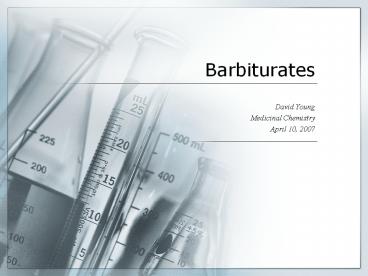Barbiturates - PowerPoint PPT Presentation
Title:
Barbiturates
Description:
Depressants of the central nervous system (CNS) that impair or reduce the ... Caused the death of many celebrities such as Jimi Hendrix and Marilyn Monroe ... – PowerPoint PPT presentation
Number of Views:408
Avg rating:3.0/5.0
Title: Barbiturates
1
Barbiturates
- David Young
- Medicinal Chemistry
- April 10, 2007
2
Barbiturates
- All derivatives of Barbituric acid
- Depressants of the central nervous system (CNS)
that impair or reduce the activity of the brain
by acting as a Gamma Amino Butyric Acid (GABA)
potentiators - Categorized as hypnotics and also called
downers - Produce alcohol like symptoms such as impaired
motor control (ataxia), dizziness, and slower
breathing and heart rate
3
History
- Barbituric acid was first created in 1864 by a
German scientist named Adolf von Baeyer. It was
a combination of urea from animals and malonic
acid from apples. - Its first derivative utilized as medicine was
used to put dogs to sleep but was soon produced
by Bayer as a sleep aid in 1903 called Veronal - Phenobarbital was soon discovered and marketed as
well as many other barbituric acid derivatives - Prescribed as sedatives, anesthetics,
anxiolytics, and anti-convulsants - Also popular and abused in pop culture because of
their alcohol like effects - Interesting facts
- Caused the death of many celebrities such as Jimi
Hendrix and Marilyn Monroe - Used by the Nazis during WWII for euthanasia
4
Types
- Barbituric Acid
Amobarbital
Phenobarbital
Pentobarbital
5
Synthesis
Malonic Acid Urea
Barbituric Acid
- Barbituric acid is synthesized by a condensation
reaction that results in the release of H2O
(dehydration) and the heterocyclic pyrimidine - Further substitution of side chains on the ring
produce the pharmacologically active barbiturates
6
Mechanism of Action
Barbiturates potentiate the effect of GABA at the
GABA-A receptor. The GABA-A receptor is a ligand
gated ion channel membrane receptor that allows
for the flow of Cl through the membrane in
neurons. GABA is the principle neurotransmitter
for this receptor which upon binding causes the
channel to open and creates a negative change in
the transmembrane potential. This makes it an
Inhibitory neurotransmitter
- GABA binding site
- Barbiturate binding site
GABA
7
Mechanism of Action
- Barbiturates potentiate the effect of GABA by
binding to the GABA-A receptor at a nearby site
and increasing the chloride flow through the
channel. Barbiturates also block the AMPA
receptor which is sensitive to glutamate, the
excitatory neurotransmitter. Glutamate performs
the opposite effect from GABA restricting ion
flow and increasing the transmembrane action
potential of the neuron. By blocking this action
Barbiturates serve to increase the duration of
the receptor response to GABA and extend the
depressed condition of the cell.
8
Uses
- Barbiturates have been use in the past to treat a
variety of symptoms from insomnia and dementia to
neonatal jaundice - They have largely been replaced with drugs such
as benzodiazepine due to their propensity for
addiction and reduced effect over extended use - Still widely used to treat most seizures
including neonatal seizures - Used when benzo class drugs fail or in
underdeveloped countries - Cannot be used for treatment of absence seizures
9
Future Research
- Research continues to develop for Barbiturates as
anti-convulsants. More particularly research is
being performed to test the prophylactic value of
barbiturates in situations such as pre and
perinatal asphyxia and epilepsy.































